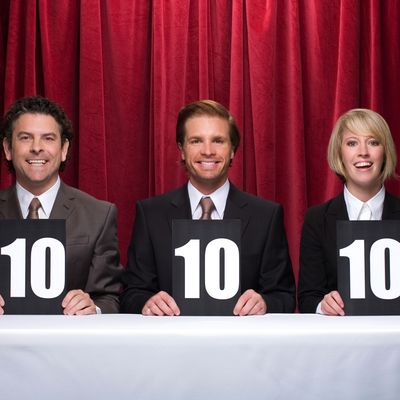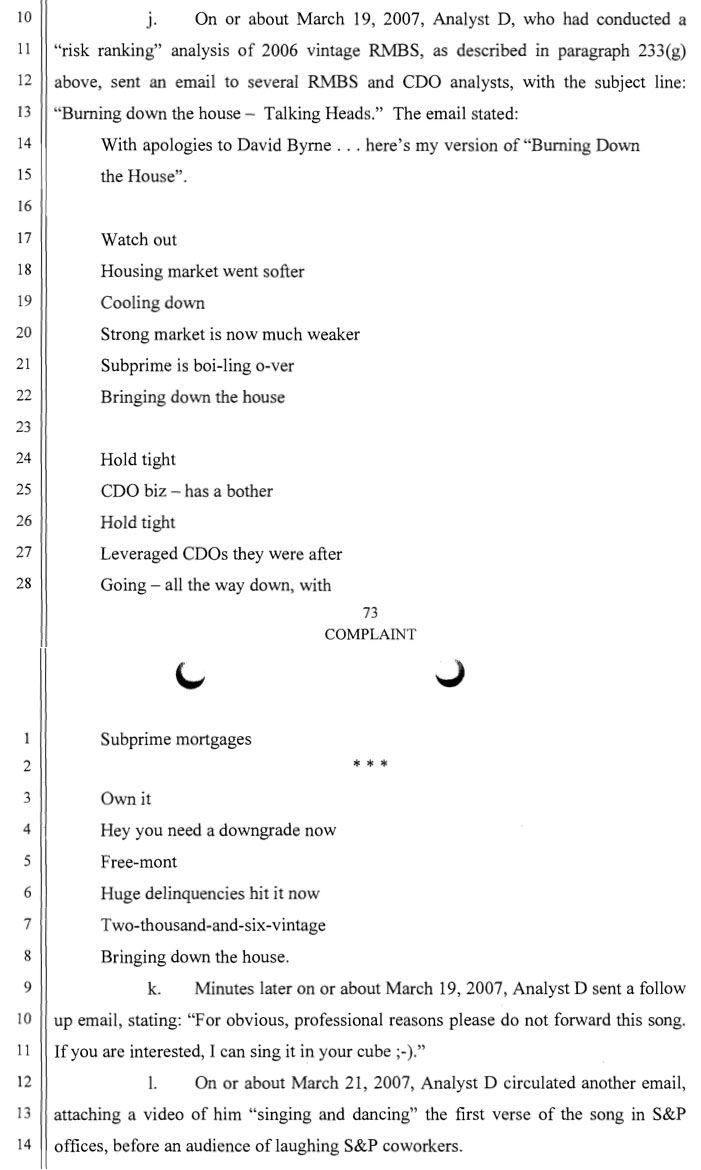
There is a lot to think about in the Justice Department’s 128-page complaint against Standard & Poor’s, released today as part of a massive lawsuit alleging that the rating agency intentionally inflated ratings for mortgage-backed securities during the financial crisis, giving investors a false sense of security and creating billions of dollars in losses when the housing market collapsed.
The complaint (which can be found in full here, although I warn you that it’s not light reading) resembles in some ways a three-act play.
Act One takes place in 2006-2007, and contains the story of how, in the lead-up to the crisis, S&P repeatedly ignored signs (including warnings from its own analysts) that the housing market was about to collapse, rendering its ratings of mortgage-backed securities mostly inaccurate. This is the most delightful part of the complaint, mostly because it includes the tale of an enterprising S&P analyst who decided to breathe some life into the dry topic of CDO creditworthiness by writing a jaunty parody song:

Act Two of the complaint occurs in late-ish 2007, when the housing market starts to turn, and S&P realizes that a lot of its ratings don’t reflect the actual risks of mortgage-backed securities, but neglects to change its mathematical models to reflect that fact – which results in a bunch of toxic securities getting gold-plated AAA ratings, which is good for banks that packaged and sold those securities, and less good for the poor schmucks who bought them.
Given that S&P was — and still is! — a private corporation that is paid by Wall Street banks to rate mortgage-backed securities, which these banks then sell to clients (getting higher prices for better ratings), it shouldn’t shock us that S&P massaged its models to make its ratings more favorable. S&P was losing business to Moody’s, another rating agency whose models were pumping out AAA-rated securities. So it updated its algorithms to make them more “business friendly” (read: ones that produced AAA ratings) and kept going, as evidenced by a bunch of e-mails like this:
On or about June 20, 2007, Executive J sent to Jordan an email proposing three stages for a “rating transition project” that would follow up on the approach set forth in the “Better Mousetrap” presentation. The third stage was described as “Data testing and deal testing (make sure new stuff doesn’t kill our business).” (emphasis mine)
Then there is Act Three, the falling action, which consists of a lot of paragraphs with the same form: “On [date in 2007], S&P gave an AAA rating to [pile of crap CDO stuffed with bad subprime mortgages], all of which subsequently defaulted, losing [millions of dollars] for [small, helpless financial institution].”
Peter Henning and Steven Davidoff think that the DoJ has an “uphill battle” ahead of itself in proving that S&P’s actions were illegal, since “it must prove that S.& P. ratings were the product of intentional fraud and not just stupidity.” Yes, they say, S&P showed a less-than-complete grasp of the extent of the housing crisis as it was occurring and responded too slowly, but so did almost everyone else on Wall Street. Matt Levine calls the complaint “underwhelming,” and asks why Moody’s isn’t being sued as well, if the criteria used to select DoJ targets is “rating agency that was bad at its job.”
I think the DoJ’s complaint will result in a settlement, if only because S&P surely doesn’t want this case to go to a jury. But it could have been stronger. There were many more shenanigans at ratings agencies during the crisis than made it into the complaint, including ones hinted at in a 2010 SEC suit (in which S&P was not named) in which ratings agencies were found to have made their models available to banks, the equivalent of a teacher giving the answer key to a student ahead of an exam. Too much emphasis in the DoJ’s complaint is placed on S&P’s slow response to the crisis and on its claims of objectivity, at the expense of the real, damning evidence that S&P knew its models were flawed, had better models ready to be swapped in, but kept using the old models because they spit out more positive ratings and made them more money.
Proving that ratings agencies are incompetent is easy. (In fact, most of the market thinks so already, as evidenced by the fact that sovereign bond markets routinely respond to downgrades by shrugging.) Proving that they’re intentionally fraudulent is harder — and, unfortunately for the DoJ, Talking Heads parody songs don’t count as a smoking gun.





























